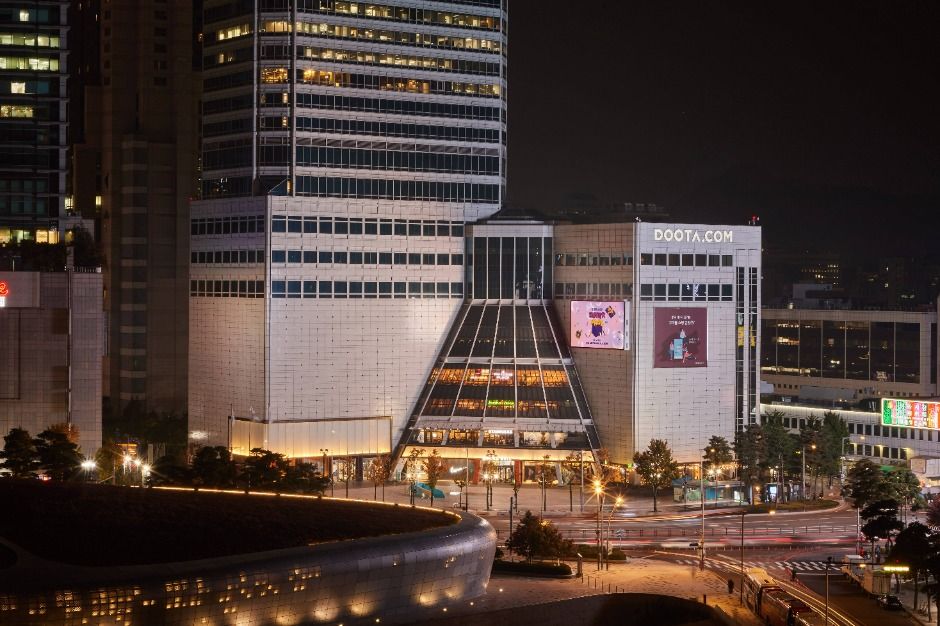Doota Mall (두타몰)
2.0Km 2025-10-23
275, Jangchungdan-ro, Jung-gu, Seoul
Doota Mall is a must-visit shopping destination that represents Dongdaemun-the center of K-fashion and culture in Seoul. Doota offers a true one-stop shopping experience across fashion, beauty, lifestyle, and dining-from K-designers, sportswear, women and men's apparel to a wide variety of cafes and restaurents. Open until midnight, Doota welcomes intenational travelers with special gifts and exclusive benefits.
Olive Young - Doota Branch [Tax Refund Shop] (올리브영 두타)
2.0Km 2024-04-19
4F-51, Doosan Tower Bldg., 275, Jangchungdan-ro, Jung-gu, Seoul
-
Arirang 331 - Doota Branch [Tax Refund Shop] (아리랑331 두타)
2.0Km 2024-04-18
4F-028, 275, Jangchungdan-ro, Jung-gu, Seoul
-
National Geographic - Doota Branch [Tax Refund Shop] (내셔널지오그래픽 두타)
2.0Km 2024-04-18
B1F #05, 275, Jangchungdan-ro, Jung-gu, Seoul
-
CK - Doota Branch [Tax Refund Shop] (CK 두타)
2.0Km 2024-04-22
147, Gijanghaean-ro, Gijang-eup, Gijang-gun, Busan
-
Mensa - Doota Branch [Tax Refund Shop] (MENSA 두타)
2.0Km 2024-04-22
147, Gijanghaean-ro, Gijang-eup, Gijang-gun, Busan
-
Orange Multi MLB - Doota Branch [Tax Refund Shop] (오렌지멀티 MLB 두타)
2.0Km 2024-04-18
B1-005, Doosan Tower Bldg., 275, Jangchungdan-ro, Jung-gu, Seoul
-
Style Fit - Doota Branch [Tax Refund Shop] (STYLE FIT 두타)
2.0Km 2024-04-18
3F-041, Doosan Tower Bldg., 275, Jangchungdan-ro, Jung-gu, Seoul
-
Onitsuka Tiger - Doota Branch [Tax Refund Shop] (오니츠카타이거 두타)
2.0Km 2024-04-19
Store #21, B1, 275, Jangchungdan-ro, Jung-gu, Seoul
-


![Olive Young - Doota Branch [Tax Refund Shop] (올리브영 두타)](http://tong.visitkorea.or.kr/cms/resource/99/2878699_image2_1.jpg)
![Arirang 331 - Doota Branch [Tax Refund Shop] (아리랑331 두타)](http://tong.visitkorea.or.kr/cms/resource/00/2878700_image2_1.jpg)
![National Geographic - Doota Branch [Tax Refund Shop] (내셔널지오그래픽 두타)](http://tong.visitkorea.or.kr/cms/resource/04/2878704_image2_1.jpg)
![CK - Doota Branch [Tax Refund Shop] (CK 두타)](http://tong.visitkorea.or.kr/cms/resource/07/2878707_image2_1.jpg)
![Mensa - Doota Branch [Tax Refund Shop] (MENSA 두타)](http://tong.visitkorea.or.kr/cms/resource/08/2878708_image2_1.jpg)
![Orange Multi MLB - Doota Branch [Tax Refund Shop] (오렌지멀티 MLB 두타)](http://tong.visitkorea.or.kr/cms/resource/10/2878710_image2_1.jpg)
![Onitsuka Tiger - Doota Branch [Tax Refund Shop] (오니츠카타이거 두타)](http://tong.visitkorea.or.kr/cms/resource/14/2878714_image2_1.jpg)
 English
English
 한국어
한국어 日本語
日本語 中文(简体)
中文(简体) Deutsch
Deutsch Français
Français Español
Español Русский
Русский